.
Researchers using the Stratospheric Observatory for Infrared Astronomy (SOFIA) have captured new images of a ring of gas and dust seven light-years in diameter surrounding the supermassive black hole at the center of the Milky Way, and of a neighboring cluster of extremely luminous young stars embedded in dust cocoons.
The images of our galaxy's Circumnuclear Ring (CNR) and the neighboring Quintuplet Cluster (QC) are the subjects of two posters presented this week during the American Astronomical Society's meeting in Long Beach, Calif. Ryan Lau of Cornell University and his collaborators studied the CNR. Matt Hankins of the University of Central Arkansas in Conway is lead author of the other paper, regarding the QC.
SOFIA is a highly modified Boeing 747SP aircraft carrying a telescope with an effective diameter of 100 inches (2.5 meters) to altitudes as high as 45,000 feet (14 km). The images were obtained during SOFIA flights in 2011 with the Faint Object infraRed Camera for the SOFIA Telescope (FORCAST) instrument built by a team with principal investigator Terry Herter of Cornell.
FORCAST offers astronomers the ability to see the CNR and QC regions and other exotic cosmic features whose light is obscured by water vapor in Earth's atmosphere and interstellar dust clouds in the mid-plane of the Milky Way. Neither ground-based observatories on tall mountain peaks nor NASA's orbiting Hubble space Telescope can see them.
The SOFIA images may be seen by visiting http://www.nasa.gov/sofia or http://www.sofia.usra.edu. Each image is a combination of multiple exposures at wavelengths of 20, 32, and 37 microns.
Figure 1a shows the CNR and Figure 2a shows the QC. The CNR and other exotic features revealed by SOFIA's FORCAST camera are invisible to Hubble's near-infrared camera, as shown for comparison in figures 1b and 2b. Figure 3 shows the two fields studied in these papers as square insets on a large-scale image of the galactic center made by the Spitzer Space Telescope at an infrared wavelength of 8 microns.
"The focus of our study has been to determine the structure of the Circumnuclear Ring with the unprecedented precision possible with SOFIA" said Lau. "Using these data we can learn about the processes that accelerate and heat the ring."
The nucleus of the Milky Way is inhabited by a black hole with 4 million times the mass of the sun and is orbited by a large disk of gas and dust. The CNR seen in Figure 1a is the inner edge of that disk. The galactic center also hosts several exceptionally large star clusters containing some of the most luminous young stars in the galaxy, one of which is the Quintuplet Cluster seen in Figure 2. The combination of SOFIA's airborne telescope with the FORCAST camera produced the sharpest images of those regions ever obtained at mid-infrared wavelengths, allowing discernment of new clues about what is happening near the central black hole.
"Something big happened in the Milky Way's center within the past 4 million to 6 million years which resulted in several bursts of star formation, creating the Quintuplet Cluster, the Central Cluster, and one other massive star cluster." said Hankins, lead author of the QC paper. "Many other galaxies also have so-called 'starbursts' in their central regions, some associated with central black holes, some not. The Milky Way's center is much nearer than other galaxies, making it easier for us to explore possible connections between the starbursts and the black hole."
SOFIA Chief Scientific Advisor Eric Becklin, who is working with the CNR group, determined the location of the galaxy's nucleus as a graduate student in the 1960s by laboriously scanning a single-pixel infrared detector to map the central region.
"The resolution and spatial coverage of these images is astounding, showing what modern infrared detector arrays can do when flown on SOFIA," Becklin said. "We hope to use these data to substantially advance our understanding of the environment near a supermassive black hole."
SOFIA is a joint project of NASA and the German Aerospace Center. SOFIA is based and managed at NASA's Dryden Aircraft Operations Facility in Palmdale, Calif. NASA's Ames Research Center in Moffett Field, Calif., manages the SOFIA science and mission operations in cooperation with the Universities Space Research Association headquartered in Columbia, Md., and the German SOFIA Institute at the University of Stuttgart.
.
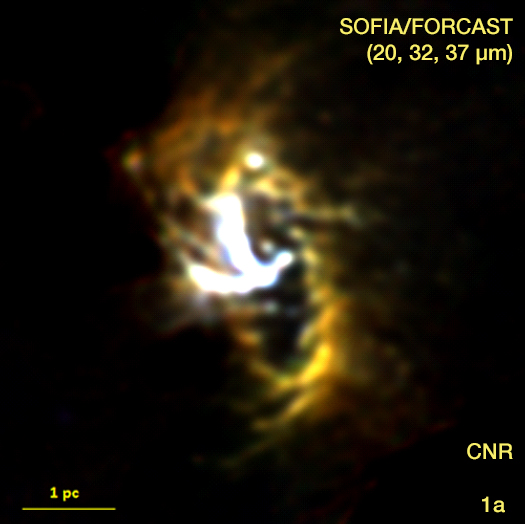
.1 pc (parsec) = 3.3 light years = 25 arcsec for a galactic center distance of 8,300 pc
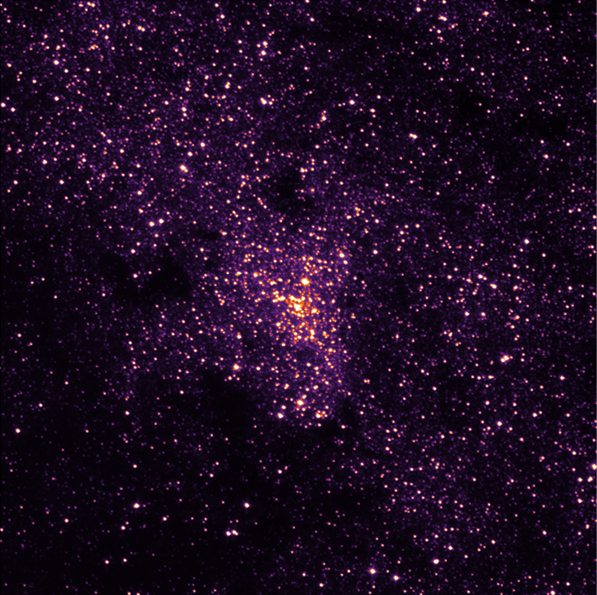
Figure 1a: SOFIA/FORCAST mid-infrared image of the Milky Way Galaxy's nucleus showing the Circumnuclear Ring (CNR) of gas and dust clouds orbiting a central supermassive black hole. The bright Y-shaped feature is believed to be material falling from the ring toward the black hole that is located where the arms of the "Y" intersect. (NASA/DLR/USRA/DSI/FORCAST Team/Lau et al. 2013) Figure 1b: HST/NICMOS near-infrared image showing the same field of view with the same scale and orientation as Figure 1a. At this wavelength, opaque dust in the plane of the Milky Way hides features that are seen in the SOFIA image. In contrast, the stars in the HST image emit mostly visible and near-infrared light and so are not seen in the SOFIA mid-infrared image. Extra opacity due to especially dense concentrations of dust in the CNR produces patches of apparently lower star density in the near-infrared image. (NASA/ESA/STScI/AURA).
.
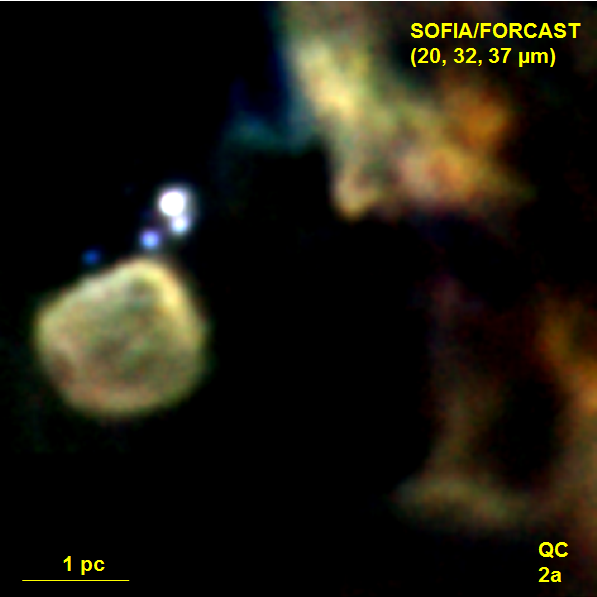
.
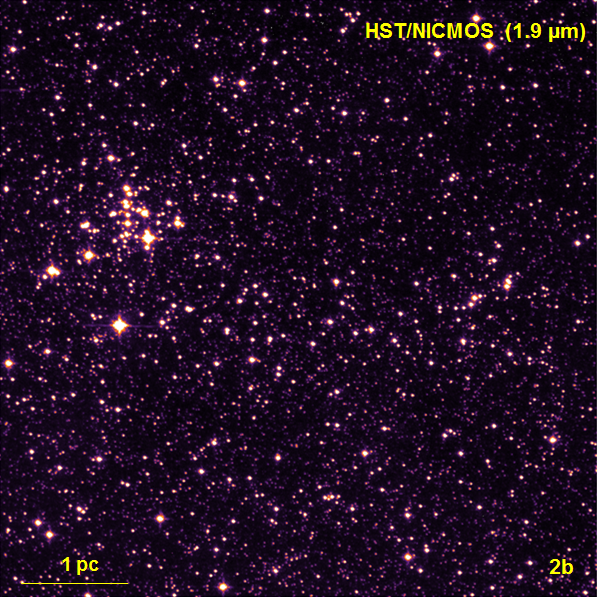
Figure 2a: SOFIA/FORCAST mid-infrared image of a region including the Quintuple Cluster (QC), a group of young stars near the left margin of the frame, located about 35 parsecs (100 light years) from the galaxy's nucleus. The compact bright objects rendered white and blue in this image are dust cloud "cocoons" heated from within by the highest-luminosity stars in the cluster to temperatures that make them prominent at mid-infrared wavelengths. Other features in this image are interstellar clouds of gas and dust. The large rounded oblong feature below the QC is an expanding cloud of debris produced by violent ejections of material from a massive star nearing the end of its life. (NASA/DLR/USRA/DSI/FORCAST Team/Hankins et al. 2013) Figure 2b: HST/NICMOS image of the QC region matching the SOFIA/FORCAST field of view in Figure 2a. The QC itself is at the left of the frame. Most of the features in the SOFIA mid-infrared image are not seen in the HST image due to their low temperatures and intervening interstellar dust. (NASA/HST/STScI/AURA)
.
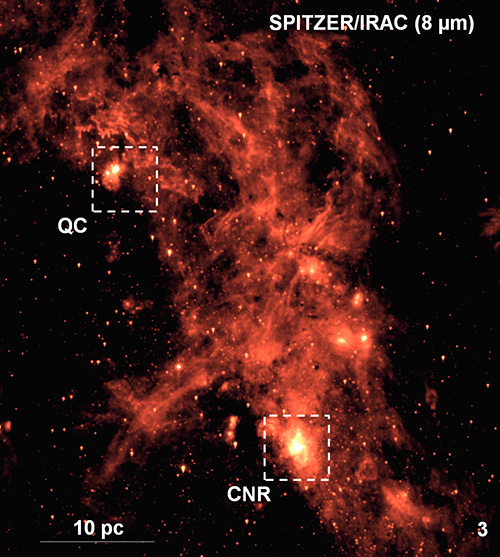
Figure 3: Spitzer Space Telescope wide-field image of the galactic center at a wavelength intermediate between those of the SOFIA/FORCAST and HST/NICMOS images. The QC and CNR field locations and orientations are shown. Effects of relative telescope sizes and sensitivities combine to makes details in the QC and CNR fields more easily studied in the mid-infrared by SOFIA than by Spitzer. (NASA/Caltech-JPL)
.
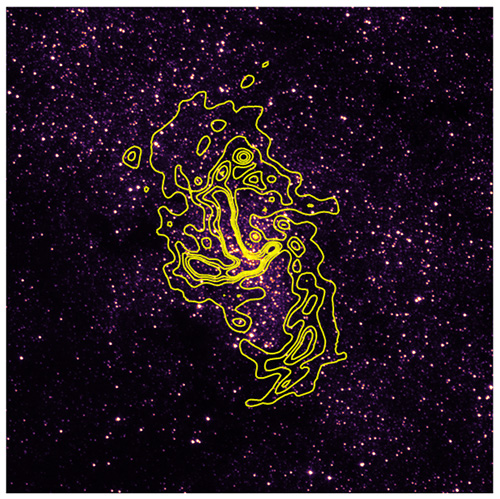
Overlay of SOFIA/FORCAST 37 micron surface brightness contours on HST/NICMOS 1.9 micron image of the Circumnuclear Ring. The 37 micron data detect thermal emission from warm dust in the CNR whereas the 1.9 micron image shows light from stars in the Galaxy's central parsec. (Figure from Lau et al. 2013, 221st AAS, poster 254.01)
.
The first four Airborne Astronomy Ambassador (AAA) educators returned safely to Earth, landing in Palmdale, Calif. early in the morning Wednesday, Feb. 13, 2013, after completing their initial flight on NASA’s Stratospheric Observatory for Infrared Astronomy, SOFIA.
That flight launched the AAA program’s first full year of operations, during which 26 educators from classrooms and science centers across the United States will fly on SOFIA as partners with scientists conducting astronomy research using the airborne observatory.
On board for the Feb. 12-13 flight were Ambassadors Constance Gartner (Wisconsin School for the Deaf, Delavan, Wisc.), Chelen Johnson (Breck School, Golden Valley, Minn.), Ira Harden, and Vincente Washington (both from City Honors College Preparatory Charter School, Inglewood, Calif.). The astronomers on the flight included Juergen Wolf and Doerte Mehlert of the German SOFIA Institute in Stuttgart, Germany and Ted Dunham of the Lowell Observatory in Flagstaff, Ariz.
SOFIA is a modified Boeing 747SP jetliner that carries a telescope with an effective diameter of 100 inches (2.5 meters) to altitudes as high as 45,000 feet (14 km). Flying above Earth’s obscuring atmospheric water vapor, scientists can gather and analyze infrared light to further our understanding of puzzles such as the processes that form stars and planets, the chemistry of organic compounds in interstellar clouds, and the environment around the supermassive black hole at the center of the Milky Way Galaxy.
“SOFIA enables educators to work with scientists and to experience a flight mission on the world’s largest airborne observatory. Educators then take their experiences back to their classrooms and communities,” said Eddie Zavala, NASA SOFIA program manager. “They can relate the excitement, hardships, challenges, discoveries, teamwork, and educational values of SOFIA and scientific research to students, teachers, and the general public.”
The Airborne Astronomy Ambassadors program is a yearly professional development opportunity extended to educators through a competitive, peer-reviewed process. Teams of two educators are paired with groups of professional astronomers who have won a parallel competitive process to use the flying telescope for their research projects. Each educator team will fly on two 10-hour missions that depart from and return to NASA’s Dryden Aircraft Operations Facility in Palmdale, Calif.
"These educators submitted applications describing how they will use what they learn from SOFIA to help promote increased public literacy in science, technology, engineering and math," said astronomer Dana Backman, manager of SOFIA's education and public outreach programs. "Published studies have shown that personally participating in scientific research increases the educators’ enthusiasm for teaching, and measurably improves their career retention rates. The same studies have shown that this enthusiasm carries over to the students with tangible increases in test scores and science fair participation.”
The current cohort of educator teams will continue flying through the summer of 2013. Information for educators wishing to apply for AAA flights in 2014 will be available starting March 1, 2013
.
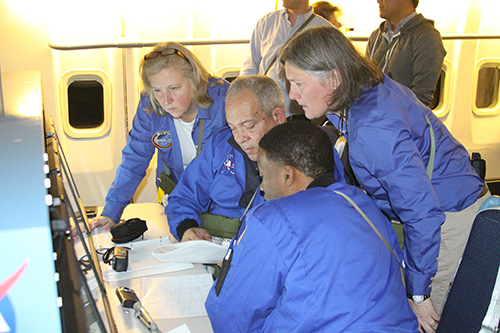
Airborne Astronomy Ambassadors (from left) Constance Gartner, Vince Washington, Ira Harden and Chelen Johnson at the educators' work station aboard the SOFIA observatory during a flight on the night of Feb. 12-13, 2013. (NASA / ASP / N. Veronico)
.
Quelle: NASA
